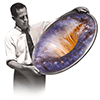 Sometimes there is more than one answer (there was a link here in The Before Days):
Sometimes there is more than one answer (there was a link here in The Before Days):
Some time ago I received a call from a colleague. He was about to give a student a zero for his answer to a physics question, while the student claimed a perfect score. The instructor and the student agreed to an impartial arbiter, and I was selected.I read the examination question:
How is it possible to determine the height of a tall building with the aid of a barometer?
The student had answered, “Take the barometer to the top of the building, attach a long rope to it, lower it to the street, and then bring it up, measuring the length of the rope. The length of the rope is the height of the building.”“Finally,” he concluded, “there are many other ways of solving the problem. Probably the best,” he said, “is to take the barometer to the basement and knock on the superintendent’s door. When the superintendent answers, you speak to him as follows: “Mr. Superintendent, here is a fine barometer. If you will tell me the height of the building, I will give you this barometer.” At this point, I asked the student if he really did not know the conventional answer to this question. He admitted that he did, but said that he was fed up with high school and college instructors trying to teach him how to think.The student was Neils Bohr.
